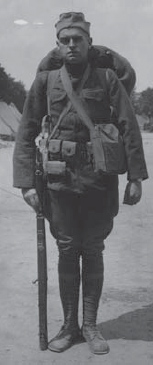

An American doughboy in full combat gear. By the time of the St Mihiel offensive American infantry had adopted a variety of clothing adapted to the rigor of combat. In addition, heavy rains resulted in American troops wearing trenchcoats during the initial phase of the attack.
First US Army
By the end of August 1918 American units in France had been blooded in a series of hard-fought engagements that highlighted the strengths and exposed the weaknesses of the American infantry. Although they had triumphed at Belleau Wood, Château-Thierry, along the Vesle River, and at Soissons, the cost in manpower had been high.
German opinion of their American opponents expressed high regard for their “morale, courage, and physique” but was dismissive of their “clumsy” tactics. Both German intelligence estimates and Pershing’s headquarters staff noted a general failure to combine fire and movement. In training with tanks prior to the assault on Cantigny in May 1918, the French advisers emphasized the need for short rushes from shellhole to shellhole and were frustrated that the Americans were reluctant to take advantage of available cover.
After the early battles of June and July 1918, Pershing and his commanders understood the tactical shortcomings of even the most veteran of their units and sought to utilize the relative lull in combat to correct the most glaring problems. On August 5 a detailed directive was released to corps and division commanders outlining the expectations for training. The instructions specifically highlighted the need for small-unit training and emphasized that “platoon, company, and battalion commanders adopt no set formation for the attack in open fields but that each commander make the best possible use of the particular ground and of the various weapons at his disposal. Rushes of individuals or small units must be covered by fire; intelligent use of fire to cover movement enables ground to be gained at relatively small cost.”
By August 1918 the quality of American divisions varied between blooded veterans and green, untested newcomers. The core of the American veteran divisions had fought in the late spring and summer at Belleau Wood, around Château-Thierry, and in the advance to the Vesle River. The 1st and 2nd divisions were joined by the 3rd, 4th, 26th, and 42nd divisions as first-rate units. The others, including the 89th and 5th divisions, had shown promise in limited roles, while the 82nd, 90th, and 91st divisions were largely untested.
The rapid expansion of the First US Army in 1917 and 1918 had resulted in the incorporation of immigrants from a multitude of countries. On September 9, 1918, as Pershing was preparing to commit the largest force of American troops since the American Civil War into combat, his headquarters issued an order allowing alien soldiers serving in Europe to file for immediate citizenship without having to return to the United States.
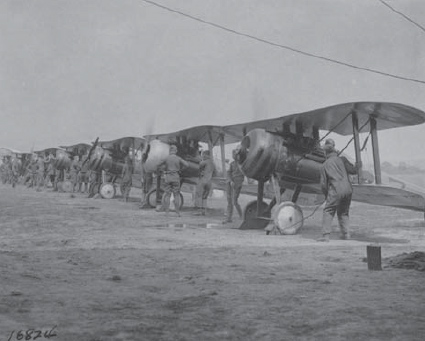
American 95th Aero Squadron. Part of the 1st Pursuit Organization, the “Kicking Mules” flew their first combat mission in March 1918. Quentin Roosevelt, youngest son of President Teddy Roosevelt, was killed in action while flying with the 95th Aero Squadron, which ended the war with 65 confirmed kills.
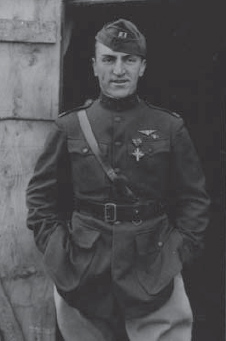
Captain Eddie Rickenbacker after being awarded the Distinguished Service Cross. Rickenbacker, who was a well-known racecar driver before the war, was America’s top ace in the war, credited with 26 enemy planes shot down.
United States Army Air Service
St Mihiel witnessed the commitment of massive air assets. The organization of American airpower in France began to take shape in January 1918 with the establishment of the 1st Pursuit and Training Center near Chalon in the Toul sector. The 95th Aero Squadron arrived in February, followed by the 136 men of the 94th Aero Squadron in early March 1918. The German offensive of March 21 forced the newly organized Americans to relocate to Epiez. The 94th Squadron, known as “Hat in the Ring,” recorded its first kill on April 14 and was rejoined by the 95th in late April. Both squadrons and support staff relocated to Toul in early May and were joined by the 27th and 147th squadrons on June 1, as the 1st Pursuit Group. Throughout this period the Americans flew missions over the Toul–St Mihiel–Pont-à-Mousson front, sparring with the 64th and 65th Jagdstaffeln and various reconnaissance groups based at Mars-la-Tour, east of Metz.
At the same time as American pursuit squadrons were being organized, the 1st Observation Squadron began operations on April 11, 1918, flying patrols over the Seicheprey–Flirey area. By May 3 the 12th Squadron had joined the 1st, followed several weeks later by the 88th Aero Squadron, to form the I Corps Observation Group. In June the 90th and 99th squadrons also became active in the Toul sector.
The 96th Aero Squadron, trained for daylight bombing, arrived at Gondrecourt on May 18, 1918, and performed its first operational raid on June 12. Over the next six weeks the squadron struck at multiple targets, including rail facilities and ammunition dumps around Metz.
Although the American Air Force conducted its initial training in the Toul sector, the German offensives of June and July followed by Allied counterattacks resulted in reassignments to the Château-Thierry sector. The 1st Pursuit Group and I Corps Observation Group, joined by three balloon companies, gained invaluable experience and logged hundreds of hours over Belleau Wood, Fismes, and Soissons. The American airmen were blooded but they prepared to return to St Mihiel. While the veteran American air formations were over the Château-Thierry sector the 2nd Pursuit Group, which included the 13th and 139th aero squadrons, was being organized at Toul. They were joined by the 22nd and 49th squadrons. The 3rd Pursuit Group was also organized during this period and included the veteran 103rd Squadron, better known as the Lafayette Escadrille, and the 93rd, 28th, and 213th squadrons The 2nd and 3rd pursuit groups were joined by the newly created Day Bombardment Group composed of the 96th, 11th, and 20th squadrons. For the St Mihiel offensive the 1st Army Observation Group was composed of the 91st, 24th, and 9th squadrons.
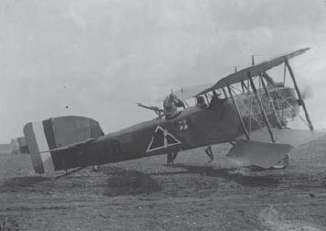
A Breguert bomber of the 96th Squadron. American flyers used a variety of French aircraft throughout the war.
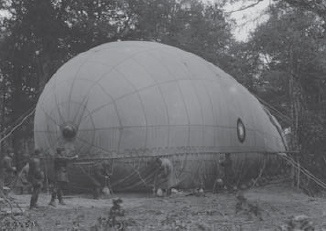
American observation balloon. Balloons of this type were used extensively to gather intelligence on enemy dispositions. They were extremely vulnerable to enemy fighters and the two-man crews were equipped with parachutes.
Colonel William “Billy” Mitchell was promoted to command the First US Army Air Service in early August 1918, and on August 26 moved his headquarters to Ligny-en-Barrios to oversee the planning and implementation of coordinated air support for the St Mihiel offensive. By September 11, 1918, Mitchell commanded the largest collection of air units designated to participate in a single offensive during World War I. The American Air Service provided 12 pursuit, ten observation, one night observation, and three day-bombardment squadrons. Mitchell also had available the French Division Aérienne, 42 pursuit and day-bombardment squadrons, eight British night-bombardment squadrons, and several Italian air units. Mitchell would command a total of 1,481 aircraft operating out of 14 separate airfields.
AEF Tank Corps
On January 1, 1918, the American Tank Corps in France was commanded by Colonel Samuel Rockenbach. While the Army Air Service could rely on support from expatriate pilots serving with the French and British, the tank force was still in its infancy. Like the Army Air Service, Rockenbach had to rely on French and British equipment and support to establish training centers. Patton was assigned as Director of the Light Tank School, which was established at Bourg in January. By March, Patton had 10 tanks for training the two companies he had already established.
That same month, Rockenbach released a revised table of organization for the Tank Corps, designating five battalions of heavy tanks and 20 of light tanks, along with their associated headquarters and support organizations. The light-tank battalions would be numbered 1–40, and the heavy battalions 41–50. The 1st Light Tank Battalion was established on April 28, 1918. At Patton’s direction a shoulder patch was designed by his staff, featuring a pyramid divided into red, yellow, and blue sections representing the firepower of artillery, the maneuverability of the cavalry, and the ability to hold ground of the infantry. A second light-tank battalion was organized on June 6, 1918. During this period Patton, recently promoted to lieutenant-colonel, and his staff developed a unique American tactical doctrine, drawing from the experience of both the British and French. Heavy tanks would lead the assault, opening paths through the wire and across trenches and engaging enemy strongpoints. Light tanks, supported by the infantry, were expected to advance 100yds behind the heavy tanks and eliminate any remaining enemy concentrations. During this time the numbering protocol was also revised to designate the 1st and 2nd light-tank battalions as the 326th and 327th battalions.
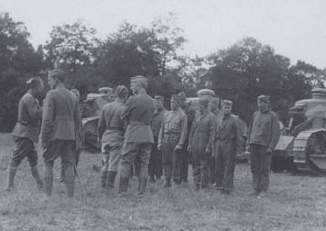
Patton (center) with members of his staff and tank crews during training. Patton recognized the combat potential of tanks and was responsible for the development of the initial organization of American tank battalions.
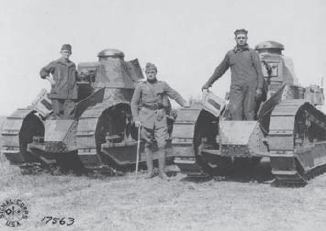
American tanks with crews. The tank on the right is equipped with a 7.92mm Hotchkiss machine gun while the tank on the left has a 37mm cannon in the turret.
German Army
Although the Germans had strengthened their defensive positions throughout the St Mihiel salient – adding bands of barbed wire, concrete reinforced strongpoints, and underground dugouts – the salient had long become a secondary front for the Germans, manned by units composed of depleted formations. Only eight understrength divisions, averaging about 5,000 men each, defended the perimeter. Two additional divisions were held in reserve. Of the front-line divisions only one of the eight was considered first class.
During the Spring Offensive the Germans had adopted a new offensive doctrine characterized by heavy artillery preparation and infiltration tactics. This new tactic achieved initial success and forced the Allies to adapt. The Allies had already been implementing a policy of defense in depth, which they perfected as a response to the last German offensive in late May 1918. The success of the Amiens attack on August 8, 1918, exposed the flaws of the German defensive deployment, catching front-line defenders by surprise and overwhelming them with artillery barrages. In response, German defensive doctrine shifted toward creating a deep outpost zone in advance of the main line of resistance and emphasizing improved intelligence-gathering to discern the enemy’s plans.
American planners also recognized that German infantry formations had been allotted additional light machine guns, increasing their number to up to nine guns per company, to supplement their defensive firepower. German air strength in the salient included 213 aircraft, including approximately 84 combat aircraft, 105 reconnaissance aircraft, and 24 bombers.
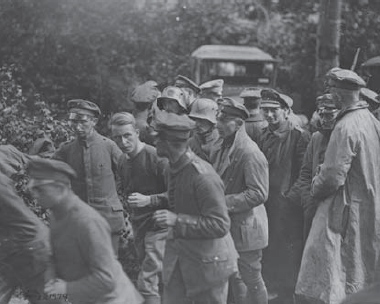
By the summer of 1918 German units varied greatly in their combat effectiveness and reflected the dwindling manpower pool available for replacements.
On August 11, 1918, the German high command issued a reprimand to the Army, drawing conclusions from the defeat of the Second Army several days before. The communiqué admonished commanders to overcome the aversion of their troops to construct adequate fieldworks, particularly antitank defenses, noting that in the Somme some tanks were able to advance several miles and managed to overrun divisional headquarters. More directly, the unwillingness of troops to defend their positions to the last round was condemned. The directive also criticized the tendency for the front line to fall back if a small number of enemy units were able to bypass front-line strongpoints.
German dispositions
The German deployment in the salient included several defensive zones. The outpost sector was composed of the Wilhelm and Schroeter zones. The Wilhelm zone formed the majority of the forward area, and was 3–6 miles deep. The narrower Schroeter zone, named for the chief engineer of the German Crown Prince’s army group, who laid out the defenses in 1917, and located at the rear of the Wilhelm zone, represented the last defensive line, protecting the interior area, which included Vigneulles and Doncourt. The Michel zone at the base of the salient included three separate defensive lines: the Hagen Stellung, Volker Stellung, and Kriemhild Stellung, all of which formed the Hindenburg Line.
Army Detachment C, under the command of Lieutenant-General Fuchs, held the salient. Army Detachment C was normally composed of 12 divisions organized into three corps. The western face was held by three divisions, known as the Combres Group, which included the 8th Landwehr Division, 13th Landwehr Division, and 35th Austro-Hungarian Regiment. The nose of the salient and a portion of the southern face was defended by the Mihiel Group, composed of the 5th Landwehr Division and the 192nd Saxon Division. The remainder of the southern face was defended by the 10th Division and 77th Reserve Division of the Gorze Group. To the east of the Gorze Group astride the Moselle River was the 255th Division of the 19th German Army. The 31st Division, 88th Division, 123rd Saxon Division, and 195th Division formed the army’s reserve. Army Detachment C was part of Army Group Gallwitz, under overall command of General Max von Gallwitz.
As early as July 1918, Lt. Gen. Fuchs had expressed continued concern about the quality of the troops assigned to defend the salient. In the event that the salient needed to be evacuated, Fuchs demanded four assault divisions, two field-artillery regiments, ten battalions of heavy artillery, and substantial air reinforcements.